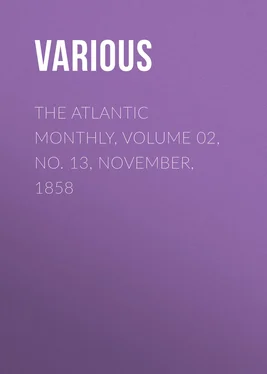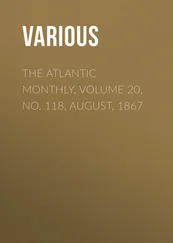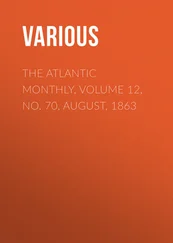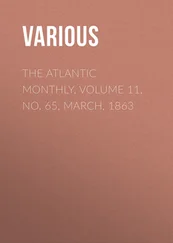Various - The Atlantic Monthly, Volume 02, No. 13, November, 1858
Здесь есть возможность читать онлайн «Various - The Atlantic Monthly, Volume 02, No. 13, November, 1858» — ознакомительный отрывок электронной книги совершенно бесплатно, а после прочтения отрывка купить полную версию. В некоторых случаях можно слушать аудио, скачать через торрент в формате fb2 и присутствует краткое содержание. Жанр: foreign_antique, periodic, foreign_edu, на английском языке. Описание произведения, (предисловие) а так же отзывы посетителей доступны на портале библиотеки ЛибКат.
- Название:The Atlantic Monthly, Volume 02, No. 13, November, 1858
- Автор:
- Жанр:
- Год:неизвестен
- ISBN:нет данных
- Рейтинг книги:4 / 5. Голосов: 1
-
Избранное:Добавить в избранное
- Отзывы:
-
Ваша оценка:
- 80
- 1
- 2
- 3
- 4
- 5
The Atlantic Monthly, Volume 02, No. 13, November, 1858: краткое содержание, описание и аннотация
Предлагаем к чтению аннотацию, описание, краткое содержание или предисловие (зависит от того, что написал сам автор книги «The Atlantic Monthly, Volume 02, No. 13, November, 1858»). Если вы не нашли необходимую информацию о книге — напишите в комментариях, мы постараемся отыскать её.
The Atlantic Monthly, Volume 02, No. 13, November, 1858 — читать онлайн ознакомительный отрывок
Ниже представлен текст книги, разбитый по страницам. Система сохранения места последней прочитанной страницы, позволяет с удобством читать онлайн бесплатно книгу «The Atlantic Monthly, Volume 02, No. 13, November, 1858», без необходимости каждый раз заново искать на чём Вы остановились. Поставьте закладку, и сможете в любой момент перейти на страницу, на которой закончили чтение.
Интервал:
Закладка:
The objectors take another step, but again put down their heavy square-toed foot, and say, "There! aren't you satisfied? you can go over grades of twenty feet per mile, but no more,—so don't try." And here English engineers stop,—twenty feet being considered a pretty stiff grade. Meanwhile, the American engineers Whistler and Latrobe, the one dealing with the Berkshire mountains in Massachusetts, the other with the Alleghanies in Virginia, find that not only are grades of ten and of twenty feet admissible, but, where Nature requires it, inclines of forty, sixty, eighty, and even one hundred feet per mile,—it being only remembered, the while, that just as the steepness of the grade is augmented, the power must be increased. This discovery, when properly used, is of immense advantage; but in the hands of those who do not understand the nice relation which exists between the mechanical and the financial elements of the question, as governed by the speed and weight of trains, and by the funds at the company's disposal, is very liable to be a great injury to the prospects of a road, or even its ruin.
It was urged at one time, that the best road would have the grades undulating from one end to the other,—so that the momentum acquired in one descent would carry the train almost over the succeeding ascent; and that very little steam-power would be needed. This idea would have place, at least to a certain extent, if the whole momentum was allowed to accumulate during the descent; but even supposing there would be no danger from acquiring so great a speed, a mechanical difficulty was brought to light at once, namely, that the resistance of the atmosphere to the motion of the train increased nearly, if not quite, as the square of the speed; so that after the train on the descent acquired a certain speed, a regular motion was obtained by the balance of momentum and resistance, —whence a fall great enough to produce this regular speed would be advantageous, but no more. On the other hand, the extra power required to draw the train up the grades much overbalances the gain by gravity in going down.
Here, then, we have the two extremes: first, spending more money than the expected traffic will warrant, to cut down hills and fill up valleys; and second, introducing grades so steep that the amount of traffic does not authorize the use of engines heavy enough to work them.
The direction of the traffic, to a certain extent, determines the rate and direction of the inclines. Thus, the Reading Railroad, from Philadelphia up the Schuylkill to Reading, and thence to Pottsville, is employed entirely in the transport of coal from the Lehigh coal-fields to tide-water in Philadelphia; and it is a very economically operated road, considering the large amount of ascent encountered, because the load goes down hill, and the weight of the train is limited only by the number of empty cars that the engine can take back.
This adoption of steep inclines may be considered as an American idea entirely, and to it many of our large roads owe their success. The Western Railroad of Massachusetts ascends from Springfield to Pittsfield, for a part of the way, at 83 feet per mile. The New York and Erie Railroad has grades of 60 feet per mile. The Baltimore and Ohio climbs the Alleghanies on inclines of 116 feet per mile. The Virginia Central Road crosses the Blue Ridge by grades of 250 and 295 feet per mile; and the ridge through which the Kingwood Tunnel is bored, upon the Baltimore and Ohio Railroad, was surmounted temporarily by grades of 500 feet per mile, up which each single car was drawn by a powerful locomotive.
Another element, of which American engineers have freely availed themselves, is curvature. More power is required to draw a train of cars around a curved track than upon a straight line. In England the radius of curvature is limited to half a mile, or thereabouts. The English railway-carriage is placed on three axles, all of which are fixed to the body of the vehicle; the passage of curves, of even a large diameter, is thus attended by considerable wear and strain; but in America, the cars, which are much longer than those upon English roads, are placed upon a pintle or pin at each end, which pin is borne upon the centre of a four-wheeled truck,—by which arrangement the wheels may conform to the line of the rails, while the body of the car is unaffected. This simple contrivance permits the use of curves which would otherwise be entirely impracticable. Thus we find curves of one thousand feet radius upon our roads, over which the trains are run at very considerable speed; while in one remarkable instance (on the Virginia Central Railroad, before named) we find the extreme minimum of 234 feet. Such a track does not admit of high speeds, and its very use implies the existence of natural obstacles which prevent the acquirement of great velocities.
In fine, the use which the engineer makes of grades and curves, when the physical nature of the country and the nature and amount of the traffic expected are known, may be taken as a pretty sure index of his real professional standing, and sometimes as an index of the moral man; as when, for example, he steepens his grades to suit the contractor's ideas of mechanics,—in other words, to save work.
Not less in the construction of bridges and viaducts, than in the preparation of the road-bed proper, does the American engineering faculty display itself. Timber, of the best quality, may be found in almost every part of the country, and nowhere in the world has the design and building of wooden bridges been carried to such perfection and such extent as in the United States. We speak here of structures built by such engineers as Haupt, Adams, and Latrobe, —and not of those works, wretched alike in design and execution, which so often become the cause of what are called terrible catastrophes and lamentable accidents, but which are, in reality, the just criticisms of natural mechanical laws upon the ignorance of pretended engineers.
Among the finest specimens of timberwork in America are the Cascade Bridge upon the New York and Erie Railroad, designed and built by Mr. Adams, consisting of one immense timber-arch, having natural abutments in the rocky shores of the creek;—the second edition of the bridges generally upon the same road, by Mr. McCallum, which replaced those originally built during the construction of the road, —these hardly needing to be taken down by other exertion than their own;—the bridges from one end to the other of the Pennsylvania Central Road, by Mr. Haupt;—the Baltimore and Ohio "arch-brace" bridges, by Mr. Latrobe;—and the Genessee "high bridge," (not a bridge, by the way, but a trestle,) near Portageville, by Mr. Seymour, which is eight hundred feet long, and carries the road two hundred and thirty feet above the river, having wooden trestles (post and brickwork) one hundred and ninety feet high, seventy-five feet wide at base, and twenty-five feet at top, and carrying above all a bridge fourteen feet high; containing the timber of two hundred and fifty acres of land, and sixty tons of iron bolts, costing only $140,000, and built in the short time of eighteen months. This structure, if replaced by an earth embankment, would cost half a million of dollars, and could not be built in less than five years by the ordinary mode of proceeding. 2 2 Lest these statements should sound extravagant, the reader will please reckon up the amounts for himself. A bank twenty-five feet wide on top, eight hundred feet long, and two hundred and thirty feet high, would contain two million cubic yards of earth; which, at twenty-five cents per yard, would cost half a million of dollars, exclusive of a culvert to pass the river, of sixty, eighty, or one hundred feet span and seven hundred feet long. Twenty trains per day, of thirty cars each, one car holding two yards, would be twelve hundred yards per day; two million, divided by twelve hundred, gives 1,666 days.
Интервал:
Закладка:
Похожие книги на «The Atlantic Monthly, Volume 02, No. 13, November, 1858»
Представляем Вашему вниманию похожие книги на «The Atlantic Monthly, Volume 02, No. 13, November, 1858» списком для выбора. Мы отобрали схожую по названию и смыслу литературу в надежде предоставить читателям больше вариантов отыскать новые, интересные, ещё непрочитанные произведения.
Обсуждение, отзывы о книге «The Atlantic Monthly, Volume 02, No. 13, November, 1858» и просто собственные мнения читателей. Оставьте ваши комментарии, напишите, что Вы думаете о произведении, его смысле или главных героях. Укажите что конкретно понравилось, а что нет, и почему Вы так считаете.












